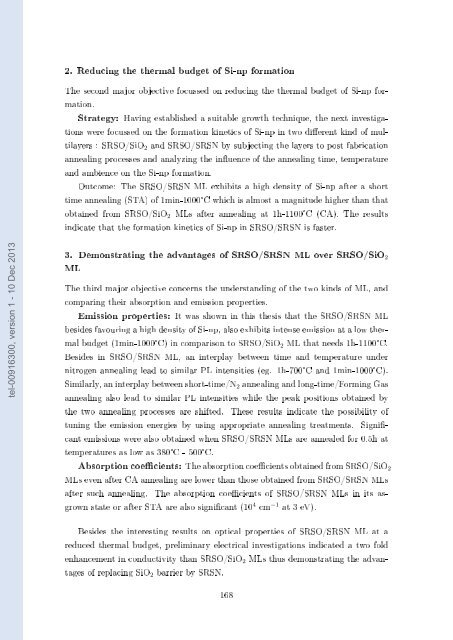Films minces à base de Si nanostructuré pour des cellules ...
Films minces à base de Si nanostructuré pour des cellules ...
Films minces à base de Si nanostructuré pour des cellules ...
Create successful ePaper yourself
Turn your PDF publications into a flip-book with our unique Google optimized e-Paper software.
2. Reducing the thermal budget of <strong>Si</strong>-np formation<br />
The second major objective focussed on reducing the thermal budget of <strong>Si</strong>-np formation.<br />
Strategy: Having established a suitable growth technique, the next investigations<br />
were focussed on the formation kinetics of <strong>Si</strong>-np in two dierent kind of multilayers<br />
: SRSO/<strong>Si</strong>O 2 and SRSO/SRSN by subjecting the layers to post fabrication<br />
annealing processes and analyzing the inuence of the annealing time, temperature<br />
and ambience on the <strong>Si</strong>-np formation.<br />
Outcome: The SRSO/SRSN ML exhibits a high <strong>de</strong>nsity of <strong>Si</strong>-np after a short<br />
time annealing (STA) of 1min-1000°C which is almost a magnitu<strong>de</strong> higher than that<br />
obtained from SRSO/<strong>Si</strong>O 2 MLs after annealing at 1h-1100°C (CA). The results<br />
indicate that the formation kinetics of <strong>Si</strong>-np in SRSO/SRSN is faster.<br />
tel-00916300, version 1 - 10 Dec 2013<br />
3. Demonstrating the advantages of SRSO/SRSN ML over SRSO/<strong>Si</strong>O 2<br />
ML<br />
The third major objective concerns the un<strong>de</strong>rstanding of the two kinds of ML, and<br />
comparing their absorption and emission properties.<br />
Emission properties: It was shown in this thesis that the SRSO/SRSN ML<br />
besi<strong>de</strong>s favouring a high <strong>de</strong>nsity of <strong>Si</strong>-np, also exhibits intense emission at a low thermal<br />
budget (1min-1000°C) in comparison to SRSO/<strong>Si</strong>O 2 ML that needs 1h-1100°C.<br />
Besi<strong>de</strong>s in SRSO/SRSN ML, an interplay between time and temperature un<strong>de</strong>r<br />
nitrogen annealing lead to similar PL intensities (eg. 1h-700°C and 1min-1000°C).<br />
<strong>Si</strong>milarly, an interplay between short-time/N 2 annealing and long-time/Forming Gas<br />
annealing also lead to similar PL intensities while the peak positions obtained by<br />
the two annealing processes are shifted. These results indicate the possibility of<br />
tuning the emission energies by using appropriate annealing treatments. <strong>Si</strong>gnicant<br />
emissions were also obtained when SRSO/SRSN MLs are annealed for 0.5h at<br />
temperatures as low as 380°C - 500°C.<br />
Absorption coecients: The absorption coecients obtained from SRSO/<strong>Si</strong>O 2<br />
MLs even after CA annealing are lower than those obtained from SRSO/SRSN MLs<br />
after such annealing. The absorption coecients of SRSO/SRSN MLs in its asgrown<br />
state or after STA are also signicant (10 4 cm −1 at 3 eV).<br />
Besi<strong>de</strong>s the interesting results on optical properties of SRSO/SRSN ML at a<br />
reduced thermal budget, preliminary electrical investigations indicated a two fold<br />
enhancement in conductivity than SRSO/<strong>Si</strong>O 2 MLs thus <strong>de</strong>monstrating the advantages<br />
of replacing <strong>Si</strong>O 2 barrier by SRSN.<br />
168
















